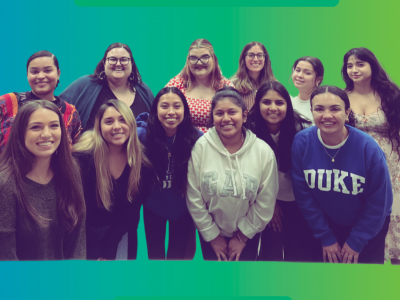Cara August, Trinity Communications

A new bilingual history exhibit documenting Latinx student life at Duke opens this week as part of the Duke Centennial celebrations.
Curated by students in Cecilia Márquez’s Latinx Social Movements class, "Our History, Our Voice: Latiné at Duke" is a collaboration of current and former cohorts of Márquez’s students from the past four years, each class building on the work of their predecessors’ research and insights.
“I think the intergenerational aspect of this exhibit makes the project interesting — it’s creating Latino history, even as it displays it,” said Márquez, who is the Hunt Family Assistant Professor of History.
The students — many of whom identify as Latino/a/x — worked in small groups to curate the exhibit’s panels by selecting the topics that were most interesting to them and conducting research at the university archives.
The final iteration of the exhibit spans over a century of history at Duke and includes topics on terminology, such as Latiné — a term akin to Latinx, which is used throughout the exhibit to refer to people of Latin American ancestry living in the United States; the first Latiné students at Duke; the evolution of campus activism; the development of Latiné student organizations; racism in academic spaces; and Black Latinés in Durham.

“There is something really powerful about this exhibit being on display at the History Department during Duke’s centennial year,” Márquez said. “It’s a statement that Latino history is Duke history — it isn’t an addendum. Latino history has been central to Duke throughout its existence.”
While celebrating Latino history is important to Márquez, it also raises questions for her about accountability and the history of segregation at Duke, and to a time when only those Latiné students who were classified as white — often international students — were permitted to enroll.
“Non-Black Latinos need to be accountable for the fact that we are part of Duke’s long history of exclusion,” she said. “This exhibit is about celebrating the amazing contributions that Latino students — especially Latino student activists — have made to transform Duke's campus, but the exhibit shows a much longer history that helps us understand the ways that Latino identity has always been complicated in the South, and at Duke in particular.”
Student curator Jaque Gomez hopes visitors to the exhibit will leave with a deeper understanding of the multifaceted nature of Latiné identities. “I hope they grow in their appreciation for the work that Latiné people have done during their time at Duke.”
A celebratory launch of the exhibit will take place on Thursday, January 25, at the Franklin Galleries in the Classroom Building on East Campus. Remarks from Duke administrators, and faculty and student curators will begin at 5 p.m. Refreshments will be served, and free event parking is available in the East Gated Lot behind the Classroom Building.
The exhibit will remain on display through December 2025.